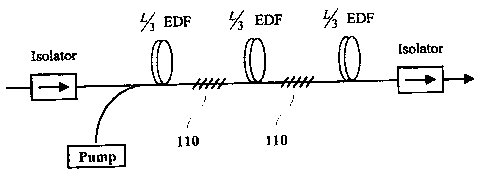Some of the information on this Web page has been provided by external sources. The Government of Canada is not responsible for the accuracy, reliability or currency of the information supplied by external sources. Users wishing to rely upon this information should consult directly with the source of the information. Content provided by external sources is not subject to official languages, privacy and accessibility requirements.
Any discrepancies in the text and image of the Claims and Abstract are due to differing posting times. Text of the Claims and Abstract are posted:
| (12) Patent: | (11) CA 2276776 |
|---|---|
| (54) English Title: | MULTI-STAGE FIBER AMPLIFIER WITH FLATTENED GAIN CURVES |
| (54) French Title: | AMPLIFICATEUR A FIBRES OPTIQUES A PLUSIEURS ETAGES ET A COURBES DE GAIN LISSEES |
| Status: | Expired and beyond the Period of Reversal |
| (51) International Patent Classification (IPC): |
|
|---|---|
| (72) Inventors : |
|
| (73) Owners : |
|
| (71) Applicants : |
|
| (74) Agent: | SMART & BIGGAR LP |
| (74) Associate agent: | |
| (45) Issued: | 2003-02-04 |
| (86) PCT Filing Date: | 1998-09-28 |
| (87) Open to Public Inspection: | 1999-04-15 |
| Examination requested: | 1999-07-05 |
| Availability of licence: | N/A |
| Dedicated to the Public: | N/A |
| (25) Language of filing: | English |
| Patent Cooperation Treaty (PCT): | Yes |
|---|---|
| (86) PCT Filing Number: | PCT/KR1998/000298 |
| (87) International Publication Number: | KR1998000298 |
| (85) National Entry: | 1999-07-05 |
| (30) Application Priority Data: | ||||||
|---|---|---|---|---|---|---|
|
This invention provides noise figure reduction and gain flatness enhancement
of a fiber amplifier using multi-stage equalizing filter. According to the
invention, noise figure can be lowered by splitting equalizing filter into
multiple stage filtering conditions.
L'invention porte sur la réduction du facteur de bruit et sur l'amélioration du lissage du gain d'un amplificateur à fibres optiques au moyen d'un filtre d'égalisation à plusieurs étages. Selon cette invention, il est possible de réduire le facteur de bruit en réalisant le filtrage d'égalisation en plusieurs niveaux de filtrage.
Note: Claims are shown in the official language in which they were submitted.
Note: Descriptions are shown in the official language in which they were submitted.

2024-08-01:As part of the Next Generation Patents (NGP) transition, the Canadian Patents Database (CPD) now contains a more detailed Event History, which replicates the Event Log of our new back-office solution.
Please note that "Inactive:" events refers to events no longer in use in our new back-office solution.
For a clearer understanding of the status of the application/patent presented on this page, the site Disclaimer , as well as the definitions for Patent , Event History , Maintenance Fee and Payment History should be consulted.
| Description | Date |
|---|---|
| Inactive: IPC expired | 2013-01-01 |
| Time Limit for Reversal Expired | 2008-09-29 |
| Letter Sent | 2007-09-28 |
| Inactive: IPC from MCD | 2006-03-12 |
| Inactive: IPC from MCD | 2006-03-12 |
| Grant by Issuance | 2003-02-04 |
| Inactive: Cover page published | 2003-02-03 |
| Pre-grant | 2002-11-13 |
| Inactive: Final fee received | 2002-11-13 |
| Notice of Allowance is Issued | 2002-05-23 |
| Letter Sent | 2002-05-23 |
| Notice of Allowance is Issued | 2002-05-23 |
| Inactive: Approved for allowance (AFA) | 2002-05-15 |
| Amendment Received - Voluntary Amendment | 2002-03-13 |
| Inactive: S.30(2) Rules - Examiner requisition | 2001-11-13 |
| Inactive: Cover page published | 1999-09-30 |
| Inactive: First IPC assigned | 1999-08-26 |
| Inactive: IPC assigned | 1999-08-26 |
| Inactive: IPC assigned | 1999-08-26 |
| Inactive: Acknowledgment of national entry - RFE | 1999-08-12 |
| Letter Sent | 1999-08-12 |
| Application Received - PCT | 1999-08-11 |
| All Requirements for Examination Determined Compliant | 1999-07-05 |
| Request for Examination Requirements Determined Compliant | 1999-07-05 |
| Application Published (Open to Public Inspection) | 1999-04-15 |
There is no abandonment history.
The last payment was received on 2002-08-22
Note : If the full payment has not been received on or before the date indicated, a further fee may be required which may be one of the following
Patent fees are adjusted on the 1st of January every year. The amounts above are the current amounts if received by December 31 of the current year.
Please refer to the CIPO
Patent Fees
web page to see all current fee amounts.
| Fee Type | Anniversary Year | Due Date | Paid Date |
|---|---|---|---|
| Registration of a document | 1999-07-05 | ||
| Request for examination - standard | 1999-07-05 | ||
| Reinstatement (national entry) | 1999-07-05 | ||
| Basic national fee - standard | 1999-07-05 | ||
| MF (application, 2nd anniv.) - standard | 02 | 2000-09-28 | 2000-05-26 |
| MF (application, 3rd anniv.) - standard | 03 | 2001-09-28 | 2001-07-26 |
| MF (application, 4th anniv.) - standard | 04 | 2002-09-30 | 2002-08-22 |
| Final fee - standard | 2002-11-13 | ||
| MF (patent, 5th anniv.) - standard | 2003-09-29 | 2003-08-21 | |
| MF (patent, 6th anniv.) - standard | 2004-09-28 | 2004-08-19 | |
| MF (patent, 7th anniv.) - standard | 2005-09-28 | 2005-08-05 | |
| MF (patent, 8th anniv.) - standard | 2006-09-28 | 2006-08-08 |
Note: Records showing the ownership history in alphabetical order.
| Current Owners on Record |
|---|
| SAMSUNG ELECTRONICS CO., LTD. |
| Past Owners on Record |
|---|
| JU HAN LEE |
| NAM KYOO PARK |